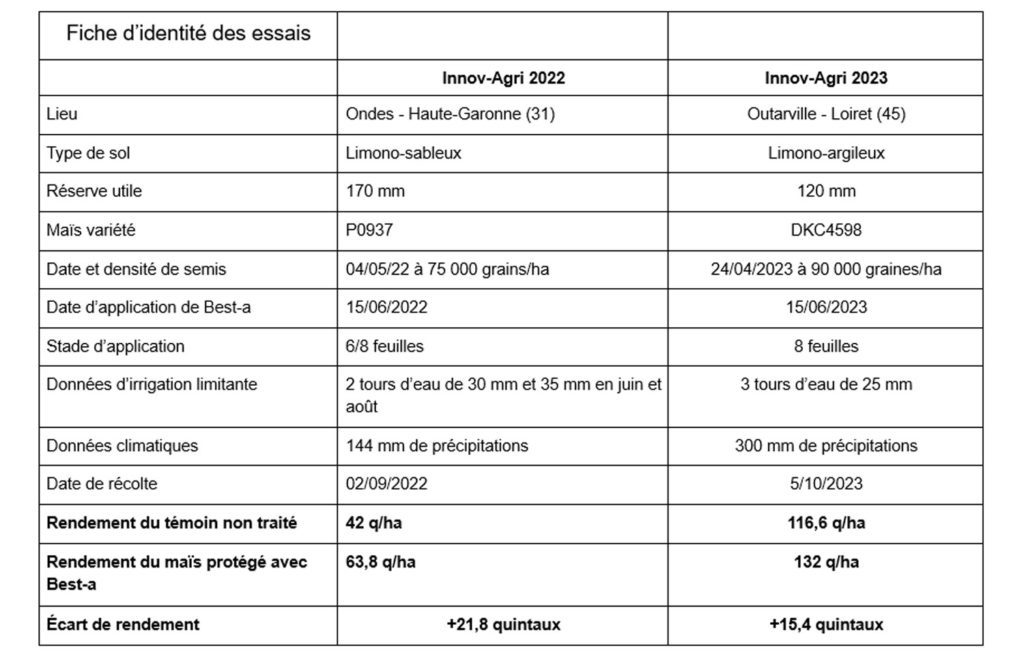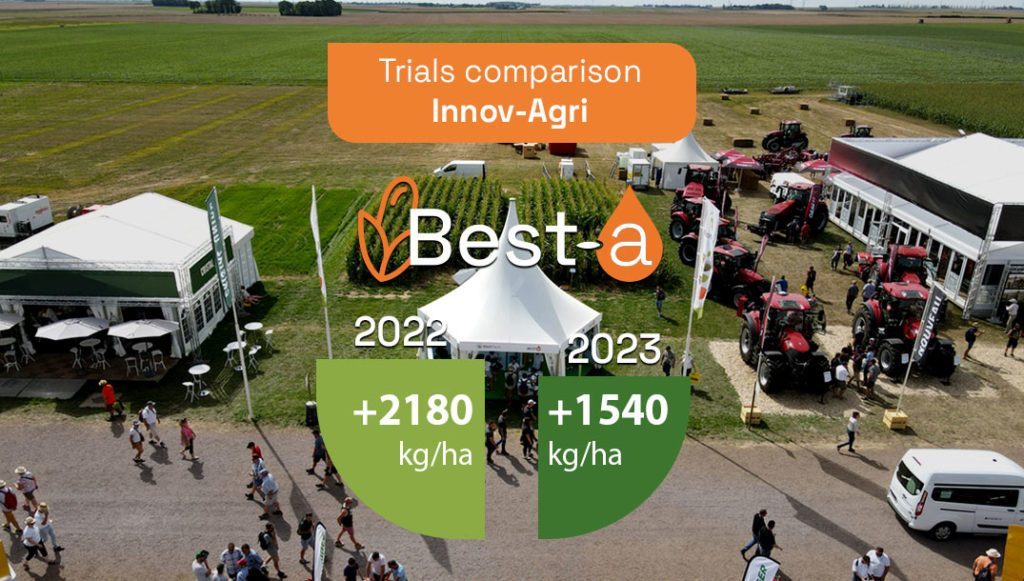The trial has been conducted for the past two years at the Innov-Agri show, and is presented to all visitors. The principle is simple: Elicit Plant plants two plots with corn using the same crop itinerary, the only difference being that one receives Best-a, the other does not. The aim is to observe and estimate the effects of the phytosterol-based solution in different soil and climate contexts.
In 2022, the Innov-Agri show was held in Ondes in the Haute-Garonne department of France, and in 2023, Outarville in the Loiret department. Soil types, seed varieties and sowing densities differed in both trials, but it was the weather factor that most clearly distinguished the two years.
2022 & 2023: two radically different years of weather, neither refuting the positive effect of Best-a on yields
According to the French national hydrometeorological service ‘Météo France’, 2022 was the hottest and driest year ever recorded in Haute-Garonne, with an average increase of 2.1°C compared with the norm calculated from 1991 to 2020.
In Toulouse, the thermometer read at least 25°C on 137 days of the year, compared with 78 days on average. Of these 137 days, 71 were ‘very hot’, with temperatures exceeding 30°C. Furthermore, rainfall was particularly low in 2022 with 398 mm of rain on average in the department (compared with 627 mm in a normal year), and only 150 mm from May to September. There was a first episode of intense drought at the end of June, followed by a second that lasted throughout September. Water input at the beginning of August led to a very significant ‘rewatering’ effect on the plot treated with Best-a, both much faster and greater than on the control plot, greatly improving the final yield.
In the Loiret, where the 2023 edition of the Innov-Agri show was held, the year was marked by radically different weather conditions. At the time of sowing in May, temperatures and rainfall were within seasonal norms while June was hot and stormy. July was not below normal temperatures for this month. However, cumulative rainfall was well above average in places.
Best-a effective from the first episodes of water shortage
55 mm of rain fell in July, for a cumulative total of 300 mm during the corn’s growth cycle. A heatwave rounded off the summer in late August and early September, with an average temperature of 21.8°C, in other words 1.4°C above the norm. This heat and the associated lack of water at the end of the cycle, just as the kernels were filling up, put the corn to the test. The plot treated with Best-a withstood this short, late dry spell much better than the control plot.
Armed with this data, there is no need to be a master agronomist to reach the conclusion that corn was badly affected by the climate conditions in 2022 in Ondes and did rather well in 2023 in Outarville.
Yield gains in all cases
And yet, in both cases, the effect of Best-a on performance was unmistakable.
In 2022, a year of particularly severe drought in the trial region, plots treated with Best-a showed signs of improved resistance throughout the summer. In favor of Best-a, we noted greater plant height and spike implantation, a noticeable stay green effect, better plant development after water input in August, and more consistent pre-harvest spike size and kernel fill. All these effects boded well for a better final yield for the treated plot.
In 2023, a rather rainy year in the trial region, there was no water stress in early summer and no visible differences between the control plot and the plot treated with Best-a during this period. However, at the end of the summer with the onset of the late heat, significant differences in spike size and kernel fill were observed in favor of Best-a, again boding well for a better yield from the plot treated with Best-a.
Outstanding results: an extra 2,180 kg and 1,540 kg per hectare
In both trial years, the potential yield gains were confirmed when the plots were harvested.
While yields more than doubled between the two trial years due to the impact of climatic conditions, there was nevertheless a difference in yield levels between the control plot and the Best-a treated plot in both years. An additional 2,180 kilograms were harvested in 2022 from the plot protected from water stress by Best-a, and an extra 1,540 kilograms in 2023. With its unique phytosterol-based active ingredient, Best-a thus proves its effectiveness in all climatic conditions. It buffers water stress between two water inputs, even if the drought is short-lived. It should also be noted that the presence (as in 2022) or absence (as in 2023) of observable effects during the crop cycle does not prejudge the product’s effectiveness or final yield.
Below are the details of the Elicit Plant trials following harvest of the trial plots planted at the Innov-Agri show:



